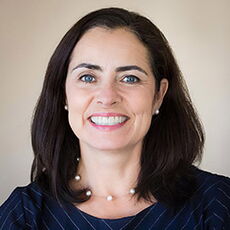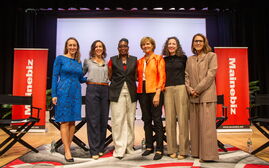
Maine Immigrants’ Rights Coalition tackles resettlement crisis
 File Photo / Tim Greenway
Mufalo Chitam, executive director of the Maine Immigrants' Rights Coalition and a 2022 Mainebiz Woman to Watch, says Maine has seen a surge of immigrants from Africa and the Middle East.
File Photo / Tim Greenway
Mufalo Chitam, executive director of the Maine Immigrants' Rights Coalition and a 2022 Mainebiz Woman to Watch, says Maine has seen a surge of immigrants from Africa and the Middle East.
The Maine Immigrants’ Rights Coalition is the organizing nucleus of a network of 97 member organizations and non-member partners who advocate for Maine immigrants to improve conditions for resettlement.
“MIRC is an example of collaborative advocacy; they talk to members and non-members and get things going,” says Gloria Ines Aponte C., senior program officer at the Maine Community Foundation.
Herself an immigrant from South America, Ines Aponte C. describes the coordination of services in Maine as disjointed. In response to a great need for organization, “MIRC shows up and effectively brings people together to attend to crises.”
Since the Wabanaki greeted European traders in the early 1600s, Maine has been populated by immigrants.

In the 1800s, Canadians came to Maine for the industrial expansion, Irish to flee the potato famine.
Nearly 4,000 immigrants came from China, Denmark, Finland, Greece, Italy, Norway, Russia, Sweden, and Syria in 1920, as told by the Maine Historical Society in the Maine History Online website. After the fall of Saigon in 1975, immigrants came from South Vietnam, Cambodia, Laos and other countries. In 2013, most immigrants arrived from Africa, Asia, Canada and the United Kingdom. Catholic Charities documents that overall, refugees in Maine have come from over 30 countries, including most recently Somalia, Sudan, Congo, Ethiopia, Burma, Iran and Iraq.
In 2019, Maine met with a great surge of refugees. “Literally overnight, the Angola population burst into Maine. Within a week or two we had over 400 people arrive in the state,” says Mufalo Chitam, executive director of the Maine Immigration Rights Coalition and a 2022 Mainebiz Woman to Watch. “When people arrived in Portland, there were no shelters, so they were housed in the Portland Expo. The immigration system was unstructured, unformalized on a federal level. There was no one to tell the states how to handle the influx, triage needs, get kids into school, language assistance, jobs, etc. States and cities didn’t share information then and [still] don’t now.”
Ines Aponte C. also remembers the crisis in 2019, “No one was coordinating in a constructive way. MIRC stepped forward.”
An evolving response
MIRC was founded in 2005 by the Immigrant Legal Advocacy Project in response to a new wave of immigrants from Congo, Rwanda, Burundi and other countries to support people whose circumstances fell outside the status of refugee. Because of their non-refugee status, there was no single standalone organization that could advocate for needs, fundraise, and provide direct services such as eldercare and childcare, or low-income and employment programs while getting state adjusted. The coalition’s purpose was to learn about each other and create collaborations, support programs and policies that promote immigrant inclusion and integration. “Immigrants need agencies that know culture, language, etc. MIRC has had to stand in the gap to create models of programming, provide shelters, create structure in an emergency situation,” says Chitam.
Initially, 20 member organizations comprised MIRC. By 2015, memberships rose to 50, and fundraising was in full swing. With fundraising came the need for MIRC to take the next step, and 2017 they became a standalone organization. Soon afterward they became a fiscal sponsor, which is a nonprofit organization that provides governance, funds management and other administrative support.
Many of MIRC’s member organizations have 501(c)3 status with the internal structure to accommodate fundraising, including channels in place for donations. They also qualify for tax exemptions, and donors may claim contributions on their taxes. Yet some members are not nonprofits. They are newly established and working to obtain this status. Other members are organizing on a much smaller scale with no plans of becoming 501(c)3s. Because MIRC is a fiscal sponsor, “A donor can go through MIRC to donate to a specific member organization. A check from MIRC is written back to the [receiving] organization leaving them to focus resources on their mission. MIRC does the financial administration for funding and reporting. Most members can’t do that work,” Chitam explains. In this way, MIRC advocates for members, so they don’t have to create the necessary robust systems. And fiscal sponsorship services are provided with no fees to members. MIRC also writes grants and will work with non-members who want to advance certain shorter-term projects that fall within the MIRC mission.
Mufalo Chitam came into the position of executive director in 2017 just as MIRC became a standalone. She brought with her extensive experience in community advocacy, fundraising, and non-profits and is deeply knowledgeable of immigrant advocacy. Chitam is also an immigrant herself and has her own story to tell. In 2000, she, her husband, who had won a green card in the lottery (also known as the Diversity Immigrant Visa Program), and their three-year-old daughter immigrated from Zambia. They came with the encouragement of the only Zambian in Maine who had encouraged them to join him in building a community. In his Portland apartment, he hosted the new family. Then, believing it would be easier for a single man to find a place than a family of three, he surrendered his home to them. Chitam says it was purely through need that they found the support to settle in Maine.
“Anyone coming outside of refugee status, support came from someone helping, community members, not state programs. When [immigrants] settled, the next [immigrants] came in and it became a chain reaction. They were being supported with childcare, housing, resources, at the grassroots level,” she says.
Chitam’s story is not uncommon. At MIRC most staff of member organizations and partners are immigrants. Many community-based programs are built around a specific ethnicity, others are a combination of ethnicities, all are immigrant focused. It is this first-hand experience, knowing what supports are needed that makes them unique.
It is also why they are effective policy makers and influencers at the state and federal levels.
They have members of the alliance who have 501(c)4 status and can legally participate in political activities under federal tax law. These members step in to further MIRC’s project and policy efforts. Some members collaborate with legislators to advance bills that align with MIRC’s priorities, for example, using foreign credentials, the ability to have a driver’s license regardless of status, and building a housing development.
The result of one such bill allowed for the creation and funding of three new crucial services: the housing navigator, who searches for housing to further family stability; the cultural broker, who speaks the language and knows the cultural needs of the individual; and the community health worker, a role that was born out of the pandemic. Other coalition members, attorneys, and their staff are experts in advocacy. At the municipal level, they know where and when policies and bills are being voted on, playing a supporting or opposition role. They plan campaigns, hold press meetings, post on social media, and work the floor in the statehouse. They act as policy leads and managers, and champion committees such as the Healthcare For All campaign.
There can be some confusion over who is an immigrant, and who is a refugee. These definitions are tied to federal and international policies. According to the United Nations High Commissioner for Refugees, “There are important differences between the terms ‘migrant’ [or immigrant] and ‘refugee’, which cannot be used interchangeably. Refugees are outside their own country because of a threat to their lives or freedom. They are defined and protected by a specific international legal framework. The term migrant [or immigrant] on the other hand, is not defined under international law, and is sometimes used differently by different stakeholders.”
Chitam discusses the direction MIRC is moving in. “It remains a challenge to predict and plan on paper because there are external factors that get us to do certain work in response to the need on the ground.”
Fiscal sponsorship will remain a service for new member organizations. As members reach their 501(c)3 status, they will stay members but no longer need extensive assistance. Then MIRC can move on to the next thing such as policy changes at a federal level.
Chitam is passionate about their mission, saying, “MIRC will continue direct services during this emergency immigration situation long enough for others to learn. We cannot look away when there are emergency needs.”Using the Donate button on the MIRC site, contributors can send donations directly to any member organization in the MIRC coalition. For those wishing to research coalition members and partners, lists with links are provided for each organization. An interactive Ecosystem Map visualizes the network of MIRC organizations, services, and supports serving and representing immigrants and refugees resettling in Maine.














0 Comments